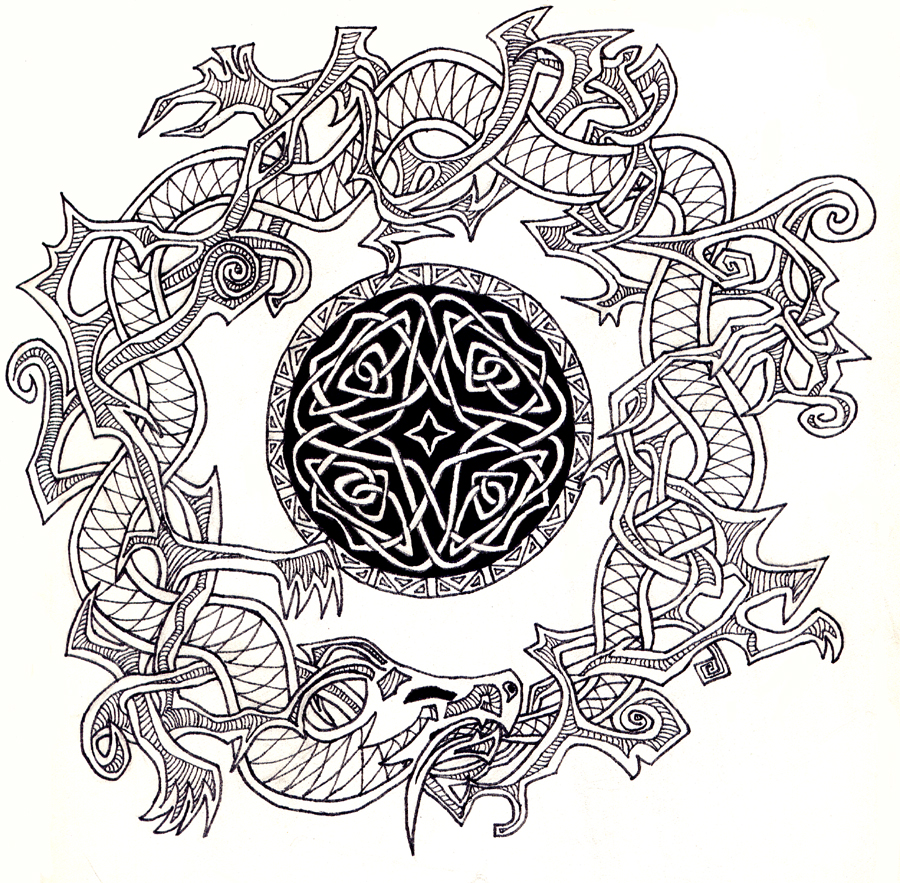I haven’t put up many of my knotwork pieces yet. Yes, little wiggly red line, I know you don’t think “knotwork” is a word. I use it to distinguish Celtic knots from the knots I get in my thread when I sew. It’s commonly used for that purpose, actually. Just google that and you’ll see about a million sites using that term for Celtic knotwork.
Besides, not all of my pieces use only Celtic knotwork. This piece also includes Manx knotwork. Yes, Manx, like the cat. It means “From the Isle of Man”. Man, Manx, makes sense, right? The Isle of Man is a fairly small British Island between England and Ireland. It’s got a bit of an odd legal state, but let’s not go into that right now. The Celts settled this island along with a lot of the other British Islands and, like the others of their kind, were fond of decorating their homes and gravestones and whatnot with knotwork. But they took a bit of a different tack with how they made their art.
Buckle in, kiddies, we’re about to get technical. This is a really good piece for talking about the differences, since I included the more traditional Celtic knotwork in here. It’s the circle in the middle. The dragon, on the other hand, follows the Manx rules. Both share a lot of their rulebook, since both are imitating real knots. Both have the over-and-under pattern of the lines, where each line, as it goes along, will alternate being on top or bottom of other lines. This pattern is what makes knotwork distinct, since it gives that woven, knotted look. They also include mainly lines. Animals and other such elements are allowed, but they’re either outside the knotwork or they are fully incorporated into it. Their legs or tails will turn into the lines, just like my dragon does. So, what’s the difference, you ask? Simple. Manx lines can fork and come together again, standard Celtic cannot. Yes, that’s about it. Things like the inclusions I put inside the lines on the dragon can also be used in Celtic pieces, and Manx pieces can also be fully geometric.
I know, it doesn’t sound like much of a difference, does it?
It does change things more than you’d expect, though. If you notice in this piece, the central circle is contained and orderly while the dragon is chaotic. This was not fully deliberate, but came forth naturally as I worked on this piece. The forking lines of Manx art mean that there can be more variety and diversity in a piece. Stuff like spikes and odd juts are encouraged, and areas can shift from a disordered tangle to a tame pair of lines without much trouble. Celtic knotwork tends to encourage following the lines, exploring their twists and turns much like a meditation labyrinth in a church. Manx is more like sailing the seas, with unexpected turns and twists, leading you to unknown places – or right back where you came from.
Perhaps that whole order versus chaos thing is why the standard Celtic form is better known. Celtic knots were spread partly by the church in their illuminated Bibles, made largely by the monastic orders. And monastic orders tend to be all about order and discipline. Celtic knots fit that beautifully, while Manx do not. Admittedly, the fact that Manx knotwork developed on the tiny little Isle of Man while the Celtic knots were on the larger, much more populous islands in the British archipelago might have made a difference.
Mind you, all this stuff about rules and styles? The Celts didn’t follow them. They came later, as people saw the old carvings and said “hey, this is cool, how do I make this?”. Then came the formulas and techniques, the rules and guidelines. Perhaps that’s why I found the Manx knotwork more freeing. It is not as wrapped up in rules and regulations as the Celtic has become. I didn’t learn it from a book with large sections detailing the ancient knots and showing how exactly to copy them, but from a panel at Balticon, where another artist who makes these pieces showed a small group of people how to do this. That’s where I learned all the history, too. It was much closer to the old ways of passing down knowledge, orally from mentor to student, so it felt deeper and closer to its roots in the ancient days. Just like this form of knotwork feels deeper and more ancient to me.

